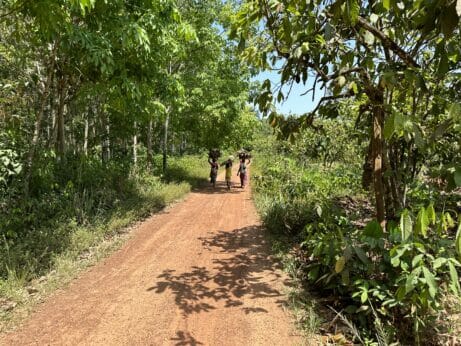This year’s Chocolate Scorecard shows who is making progress in the chocolate industry and who is falling behind.

What goes into your favorite chocolate bar? Sugar, cocoa, caramel…and potentially, a host of environmental and social issues, ranging from forced labor to deforestation.
It’s a lot to put on the shoulders of a chocolate bar. But the organizers of the annual Chocolate Scorecard say having full transparency into the cocoa industry is the first step in righting those wrongs.
This year’s scorecard, which was released last week, offers updated rankings of chocolate companies and retailers across the globe. The chocolatiers are ranked on six key metrics, decided by a team of experts in collaboration with Green America, Mighty Earth, Be Slavery Free, and the universities compiling the stats and scores: Macquarie University, The University of Wollongong and the Open University. The metrics are: traceability of products, if workers are paid a living income, if the supply chain contains child or forced labor, deforestation, agroforestry and agrichemical management.
If that feels like a lot for a chocolate bar to contribute to, it is. Cocoa, as an industry, has been rife with issues for decades. There are still roughly 1.5 million children in the cocoa industry in two countries alone, Ghana and Côte d’Ivoire. Those same countries have lost more than 80% of their forest cover in the last sixty years, and cocoa production accounts for a third of that loss. There are some smaller companies working to rid their supply chains of problems, but, overall, progress has been slow.

Newly deforested land for cocoa farming. Photography courtesy of Mighty Earth.
But with this scorecard, you can see exactly where a company or retailer ranks. The organizers and universities came up with a scoring methodology that ranks the companies in each category, and then they are given an overall score. A green egg means a company is ahead of industry standards. Yellow means it is developing good policies, and orange shows that it has made some starts but needs more work on implementing policies. A red egg means it is well behind industry standards.
“I wanted the scorecard to shed some light on who was changing to address deforestation, first in policy and then in practice,” says Etelle Higonnet, creator of Mighty Earth’s original scorecard. (Several years ago, there were multiple scorecards with the same goals; they merged in 2019 to simplify the process.) “I think it’s important to…lift everyone up, to see excellence across the board but with a level of disaggregated detail, to give [a company] credit where credit is due, but hold [that company’s] feet to the fire where needed.”
After several years of these scorecards, it’s also interesting to see which companies are making moves and implementing processes. This year, Nestle made it into the top ten companies, with green eggs in both the child and forced labor and deforestation categories. Godiva has also made progress, getting an overall score of orange, an improvement on its “rotten egg” score just two years ago. “Large corporations who are involved in chocolate recognize that they have a role in solving problems like farmer poverty, labor [and] deforestation, and they’re starting to take steps in those directions,” says Todd Larsen, executive co-director of Green America. Larsen says the progress is often “incremental,” but it’s progress nonetheless. “These problems are not new,” says Larsen. “Each of the largest companies made promises 20 years ago that they were going to address the problem of child labor in their supply chain.”

Children carrying cocoa. Photography by Fuzz Kitto.
The timeline of progress is just one of the concerns organizers raise. As the data in these surveys is self-reported, Higonnet says they have to take a “trust but verify” approach. However, if a company was found to falsify data, it would be left with PR fallout.
Then there are the companies that decline to fill out the questionnaires entirely. General Mills, makers of Häagen Dazs and Betty Crocker products, didn’t participate this year. Neither did Mondelez, makers of Cadbury products, Target, Walmart, Kroger or Whole Foods.
“It’s surprising that a company like Whole Foods wouldn’t respond,” says Larsen. “In general, they’re considered to be a company that takes sustainability fairly seriously. So you would think they would respond.” Instead, companies that fail to respond don’t get rated and are scored with a rotten egg.
One area that the scorecard doesn’t expand on at first glance is the relationship between certain companies. Tony’s Chocolonely, which scored second overall for its practices, processes its chocolate at Barry Callebaut facilities, which has an overall score of yellow. Ben & Jerry’s ice cream scored an overall yellow, but it is owned by Unilever, which declined to answer the survey as a whole.
Organizers say the relationships between the companies are factored into the scoring, which they tweak and work on from year to year. “If I’m a retailer, and [Company A] is one of my suppliers, and I find out that [Company A] has child labor in their supply chain, then what? Do I suspend [Company A]? Do I ask them to change certifications? What do I do if I find out they’re non-compliant?” says Higonnet. In short, they attempt to hold each company accountable for each step of its processes and supply chain management, although only about half of respondents have an improvement plan in place for suppliers.
There are changes coming from above as well. The EU passed a law banning cocoa that is linked to deforestation; there is a similar act in debate in the UK. Across the US, states such as New York and California are debating bills, and a federal Senate bill was introduced in the last sitting.
It’s a lot of data to keep track of, which is why the scorecard is presented as a snapshot. Organizers, who timed this year’s scorecard release to coincide with the spike in chocolate sales ahead of Easter, hope it will help customers make choices they feel good about and they will continue to spur companies and retailers to implement positive changes.
Great article, very informative. But really, no link to the actual scorecard?
One main item is missing in this article. What is being done about getting heavy metals, i.e. lead, out of the chocolate. Consumer Reports did an excellent article on this subject.
This article is ridiculously useless. Where s the ranking sheet ? We all assume that there is some sort of watchdog on these growers, but the article stops short of real useful information. Was it edited out for fear of retribution ?
Agree with Cyndy’s comment regarding heavy metals such as lead and cadmium. As You Sow is a non profit that has done some great research regarding this issue and has identified chocolate companies that need to address their supply chain practices to remove these heavy metals. Making a Venn diagram between labor practices (an important social justice issue) and processing protocols (an important heavy metal health issue) leaves a consumer with very slim choices if they want to consume chocolate.